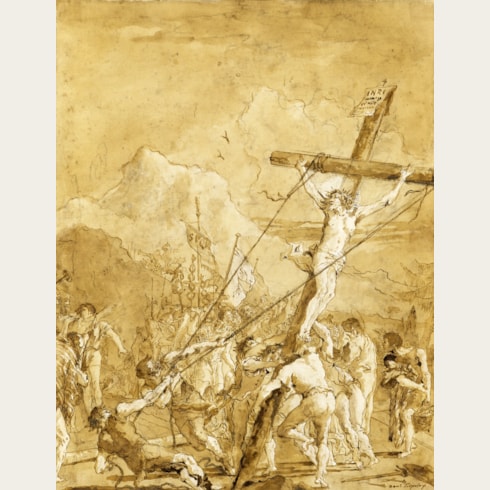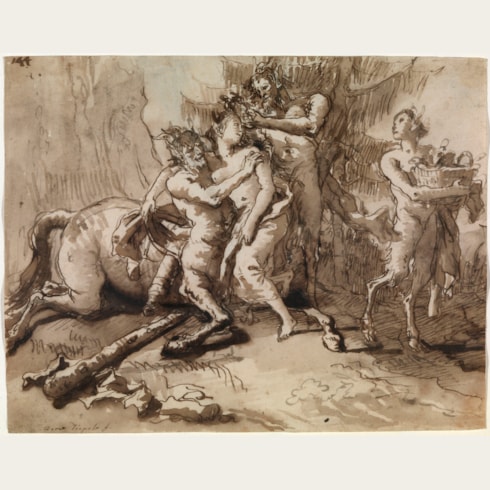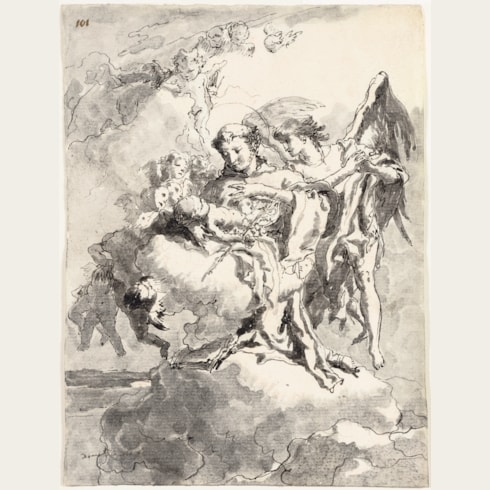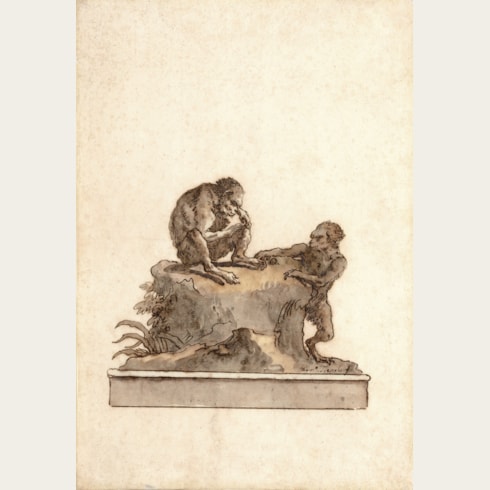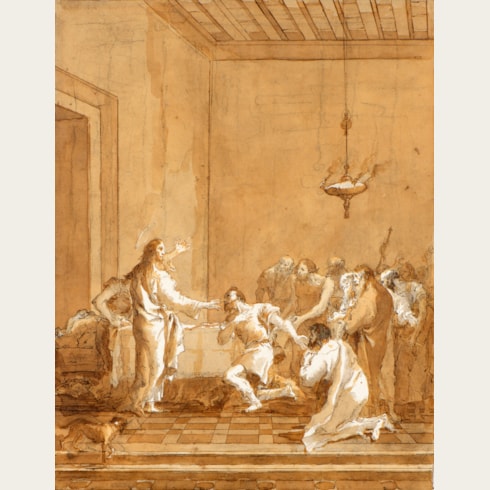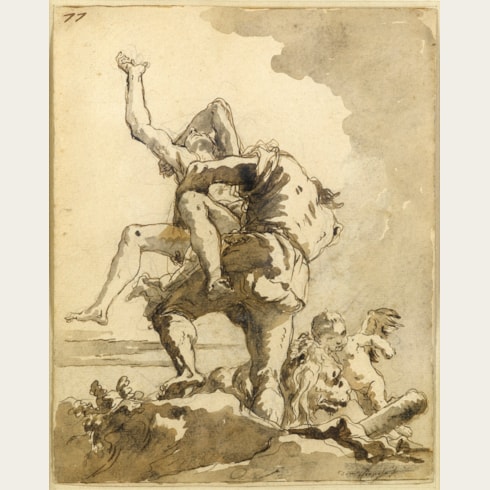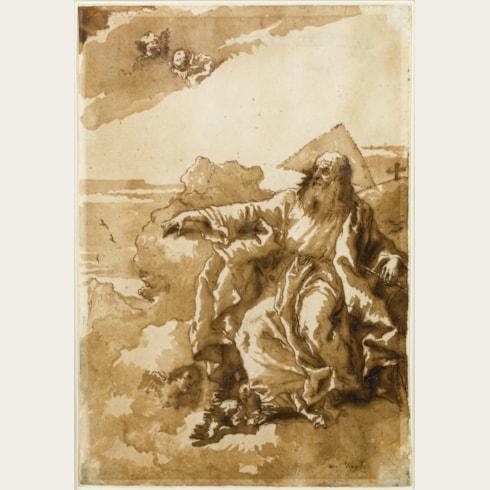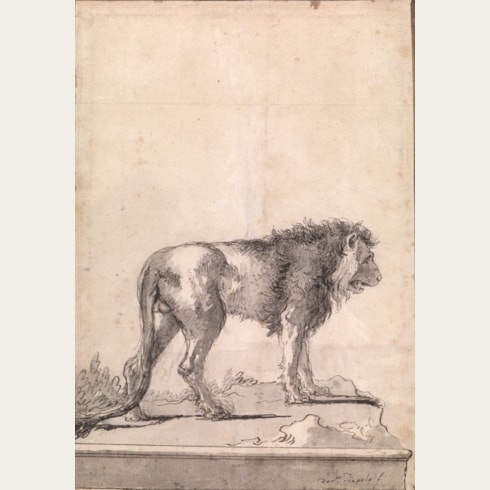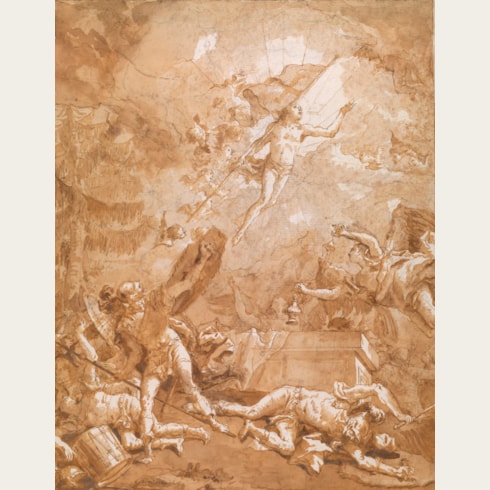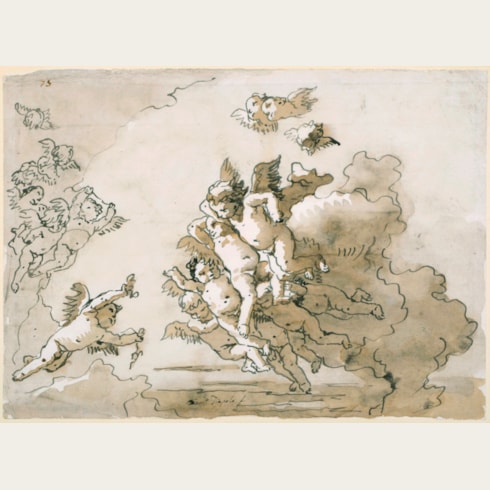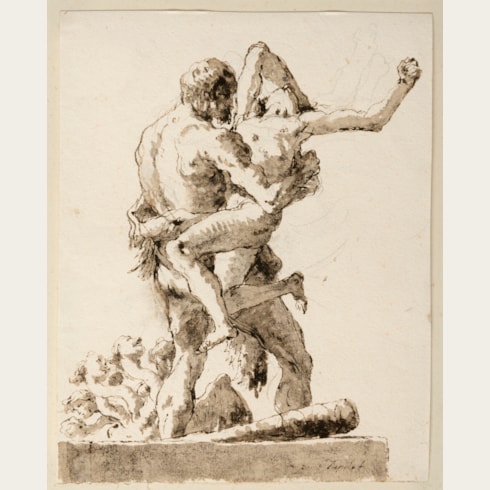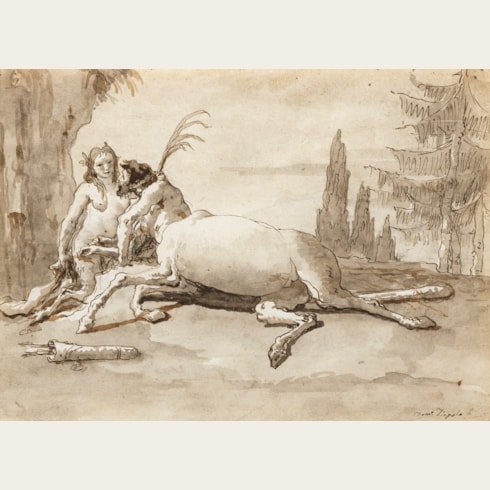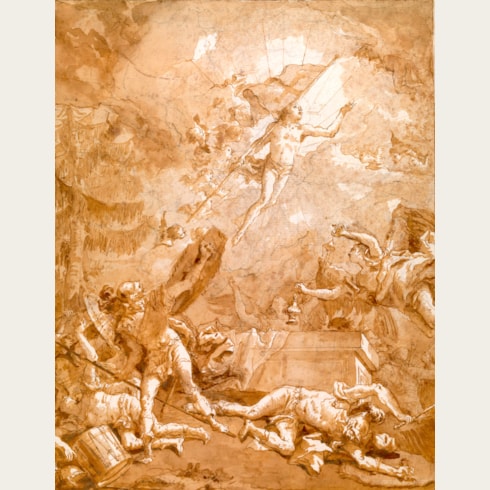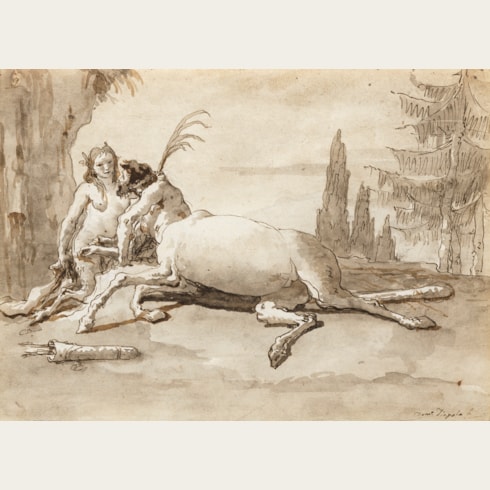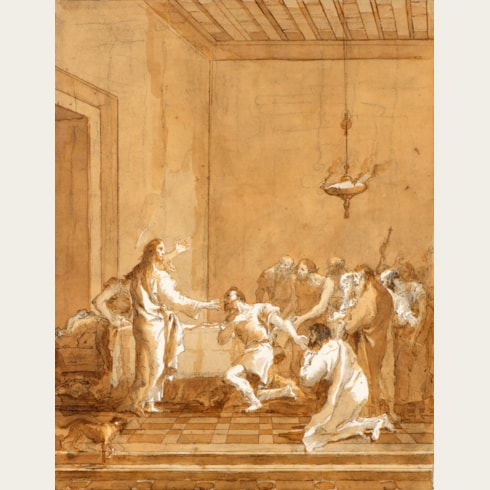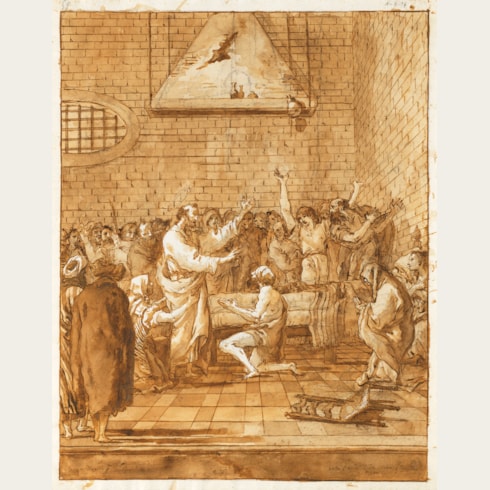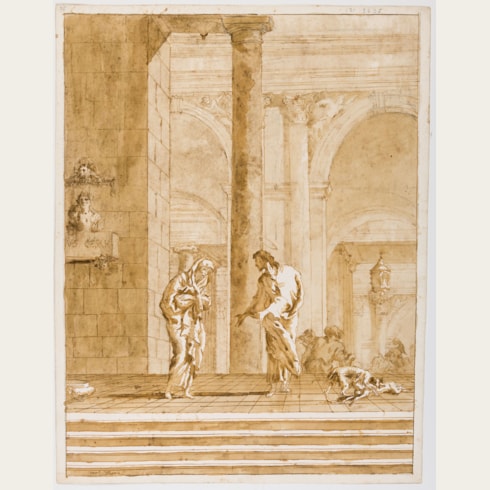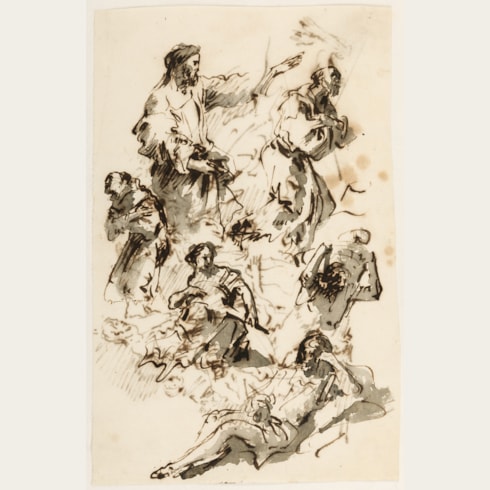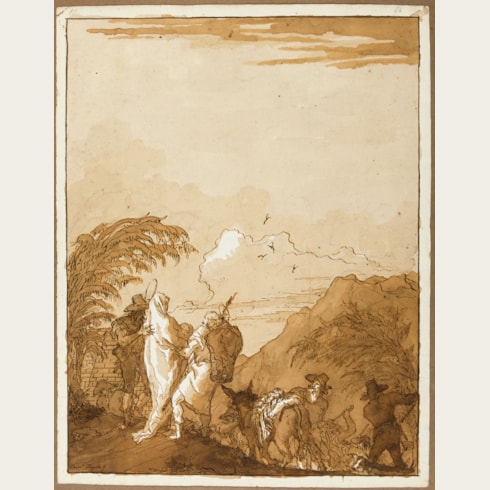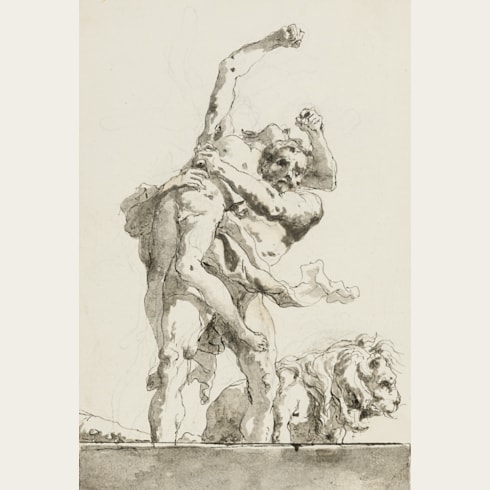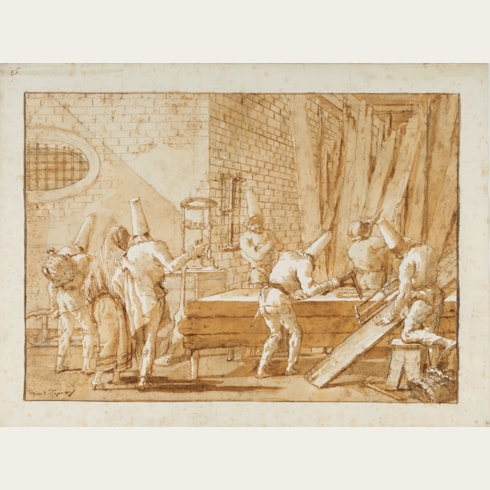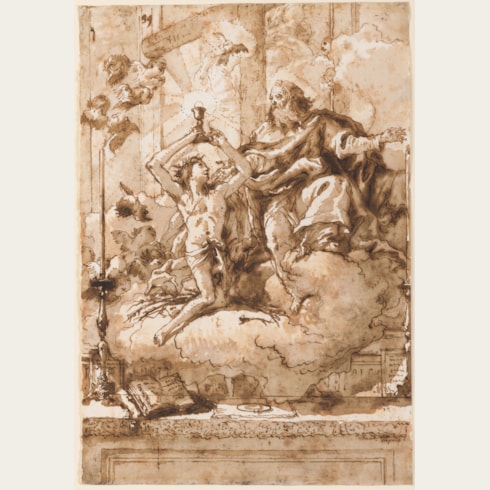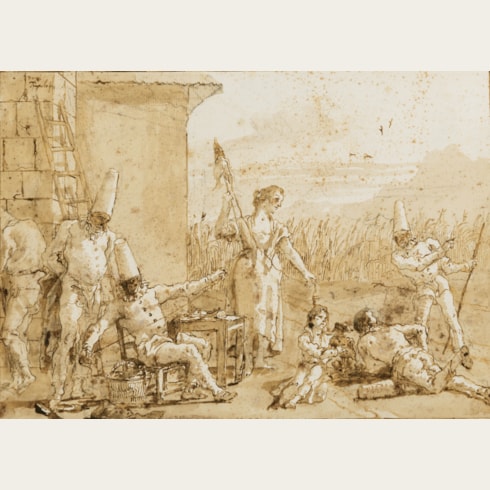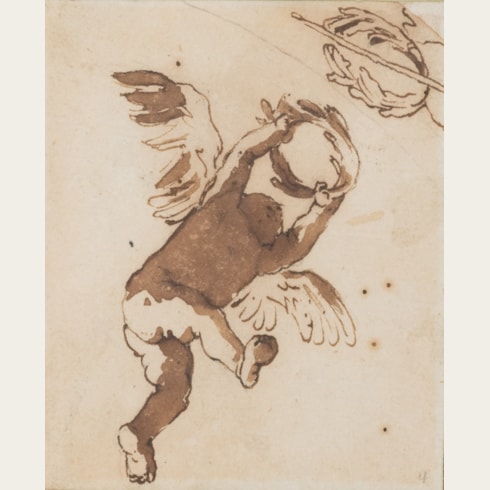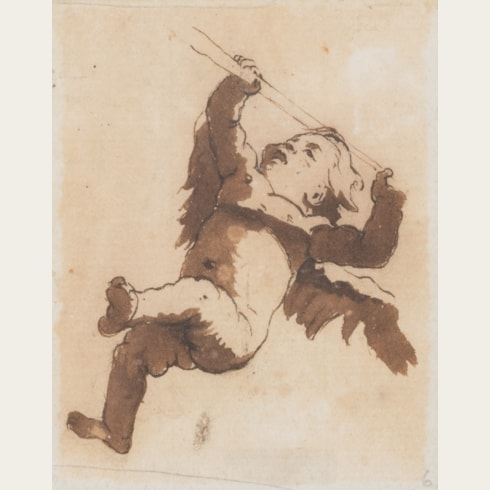Giovanni Domenico TIEPOLO
(Venice 1727 - Venice 1804)
Landscape with a Watermill
Inscribed (in a modern hand) G. B. Tiepolo / Landscape with Watermill / building[?] + trees on the verso.
Faintly inscribed from the Bliss Coll. on the verso.
130 x 214 mm. (5 1/8 x 8 3/8 in.)
As one early 20th century English writer, who was also an avid collector of Tiepolo drawings, has described these landscape studies, which he regarded as works by Giambattista, ‘They are accurate sketches from nature of buildings, mostly villas and farms in full sunlight, evidently made for the purpose of acquiring facility in handling strong lights and shadows, in which the master attained such extraordinary skill. All were obviously done with extreme rapidity...Some of the outlines may have been made with the pen, but most are brush work. The surfaces in shadow are given with simple washes, the depth of shade being indicated almost always by the tone of the wash alone without hatching. In this power of precise modulation of tint without either exaggeration or monotony, Tiepolo stands perhaps alone with Rembrandt, of whom this group of drawings in curiously reminiscent. But whereas Rembrandt’s farms are always represented in co-ordinated space as incidents in complete compositions, the Tiepolo sketches are merely detached studies. Though such farm buildings are a familiar feature in Venetian pictures from early times, it does not appear that Tiepolo ever introduced them into his finished works.’
Devoid of any human presence, these drawings in pen and wash are evocative of the heat and shadows of an Italian summer. In them, as Michael Levey has written, ‘Each shape is firmly reduced to essentials, moulded by the light and baked by the heat, so that from them there seems to exude a smell of dry straw and tile and earth, like the perennial scent of the Italian countryside in summer.’ None of these drawings appear to have been used in any painted works by Giambattista or Domenico Tiepolo, and they seem instead to have been done as a record of the unfamiliar countryside beyond their native Venice.
It seems likely that among the albums of drawings kept in the Tiepolo studio was a book of landscape sketches in pen and ink wash, and that this was one of several albums of Tiepolo drawings acquired, around the middle of the 19th century, by the English amateur artist, writer and collector Edward Cheney (1803-1884), who lived in Venice in the 1840s. The Cheney albums were in turn purchased, after his death, by the London dealers E. Parsons and Sons, and their contents dispersed over the next two or three decades. Thirty-five of the landscape drawings were bought, probably from Parsons, by the artist Alphonse Legros and eventually dispersed at two auctions in 1918. Others were acquired, also probably from Parsons, by the artists and designers Charles Ricketts and Charles Shannon, and later bequeathed to the Fitzwilliam Museum in Cambridge.
A small but significant group of eight landscape drawings by Giambattista Tiepolo is now in the Fitzwilliam Museum in Cambridge, while another set of five landscapes is in the Museum Boijmans van Beuningen in Rotterdam. Other landscape drawings of this type are today in the collections of the Kupferstichkabinett in Berlin, the Fogg Art Museum in Cambridge, Massachusetts, the British Museum and the Courtauld Gallery in London, the J. Paul Getty Museum in Los Angeles, the Metropolitan Museum of Art and the Pierpont Morgan Library in New York, the Fondation Custodia (Frits Lugt Collection) in Paris, and elsewhere.
The present sheet may have been one of the large group of Tiepolo landscape drawings acquired from the dealers E. Parsons and Sons by the etcher and draughtsman Alphonse Legros (1837-1911), and may have thence passed into the collection of Francis (Frank) Edward Bliss (1847-1930), who came to own over two thousand prints by Legros. By 1970, this drawing is recorded in the collection of the American bibliophile Douglas H. Gordon, Jr. (1902-1986), who assembled a fine group of drawings which included works by Italian, Dutch, French and English artists. Gordon owned another landscape drawing by Domenico Tiepolo, depicting a Water Gate and of identical dimensions to the present sheet, which is today in the collection of Marco Brunelli in Milan.
Giovanni Domenico Tiepolo is assumed to have begun his career in the family studio by copying his father’s drawings, although he also created his own drawings as designs for etchings, a practice which occupied much of his time in the 1740s and 1750s. His first independent drawings for paintings are those related to a series of fourteen paintings of the Stations of the Cross for the Venetian church of San Polo, completed when he was just twenty. Between 1750 and 1770, Domenico worked closely with his father as an assistant, notably in Würzburg, at the Villa Valmarana in Vicenza and the Villa Pisani at Strà, and in Madrid. From the late 1740s he also began to be entrusted with his own independent commissions, and the drawings for these display a manner somewhat different from that of his father, with a particular interest in lighthearted genre motifs.
Soon after Giambattista Tiepolo’s sudden death in Madrid in 1770, Domenico returned to his native Venice, where he enjoyed much success as a decorative painter. He continued to expound the grand manner of history painting established by his father - the ‘Tiepolo style’, as it were – and by 1780 his reputation was such that he was named president of the Accademia di Belle Arti in Venice. Within a few years, however, he seems to have largely abandoned painting. In his sixties and living effectively in retirement at the Tiepolo family villa at Zianigo, on the Venetian mainland, he produced a large number of pen and wash drawings that are a testament to his inexhaustible gift for compositional invention.
For much of the last twenty years of his career, Domenico Tiepolo seems to have painted only occasionally, and instead worked primarily as a draughtsman, producing a large number of pen and wash drawings that may collectively be regarded as perhaps his finest artistic legacy. These drawings were, for the most part, executed as a series of several dozen or more themed drawings, many of which were numbered. Among these are several series of drawings of religious and mythological subjects, as well as a varied group of genre scenes, numbering around a hundred sheets, generally referred to as the so-called ‘Scenes of Contemporary Life’, and a celebrated series of 104 drawings entitled the Divertimenti per li regazzi, illustrating scenes from the life of Punchinello, a popular character from the Commedia dell’Arte.
Domenico’s highly finished late drawings, almost all of which were signed, were undoubtedly intended as fully realized, autonomous works of art. While it is certainly possible that they were produced as works of art to be offered for sale to collectors, almost none of the drawings appear to have been dispersed in Domenico’s lifetime. The fact, too, that many of the drawings are numbered, possibly by the artist himself, and that most remained together in groups for many years after his death, would also suggest that they were retained in his studio throughout his life, as indeed he also kept numerous albums of drawings by his father. It is most likely, therefore, that these late drawings by Domenico were done simply for his own pleasure. Nevertheless, they have consistently enjoyed immense popularity since the artist’s death, and continue to entice collectors today. As Catherine Whistler has noted, ‘Domenico’s spirited and inventive independent sheets have long been appreciated, particularly by French and American collectors of the late nineteenth and early twentieth centuries; his quirky sense of humor, acutely observant eye, and zestful approach to his subjects lend his drawings a peculiarly modern appeal.’
As Michael Levey has also noted of the artist, ‘Domenico Tiepolo’s drawings provide us with the more private side of him, but they also serve to represent his career at all stages. He drew continually: sometimes very closely in the manner of his father; at the opposite remove, in the late Punchinello drawings for example, his manner and matter could never be mistaken for anyone else’s...The key to Domenico is in drawings: he began as a draughtsman and, one is tempted to say, all his paintings betray the draughtsman.’
Provenance
Probably by descent to his nephew, Colonel Alfred Capel Cure, Blake Hall, Ongar, Essex
Probably his sale, London, Sotheby’s, 29 April 1885, as part of lot 1042 (bt. Parsons)
Probably E. Parsons and Sons, London
Probably Alphonse Legros, London
Probably his sale, London, Sotheby’s, 3-4 July 1918, lot 120 (as G.B. Tiepolo: Study of an Old Mill. 6 1/2 x 7 1/4 in.)
Possibly Francis Edward Bliss, London (according to an inscription on the verso)
Douglas Huntly Gordon, Annapolis and Baltimore, Maryland, by 1970
Anonymous sale, New York, Christie’s, 30 January 1997, lot 85
Kate de Rothschild, London, in 1999
Acquired from her by Susan Lyall, Swinbrook, Oxfordshire and Little Cassiobury, Bedford Hills, New York.
Literature
Exhibition






